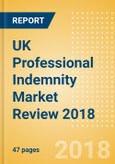UK Professional Indemnity Market Review 2018
Summary
The winds of change gathered pace in 2018, with premium rate rises and significant reductions in Lloyd’s market capacity driving a step-change in H2. Further significant changes are anticipated in 2019 as professional indemnity insurers continue taking steps to address unsustainable levels of unprofitability.
Scope
Reasons to Buy
Summary
The winds of change gathered pace in 2018, with premium rate rises and significant reductions in Lloyd’s market capacity driving a step-change in H2. Further significant changes are anticipated in 2019 as professional indemnity insurers continue taking steps to address unsustainable levels of unprofitability.
Scope
- Over the last five years much of the growth in underlying demand has occurred among non-traditional professions and SMEs.
- Legal services are among the biggest buyers of PII, and, in comparison to other professions, only doctors and dentists have a higher number of insureds.
- The technology, management consultancy, and freelance sectors can be particularly pinpointed as driving growth in the non-traditional or miscellaneous sectors. Professions impacted by the change in data protection rules through the EU’s General Data Protection Regulation (GDPR), which came into force in May 2018, have reportedly been looking more carefully at the potential benefits of PII and cyber cover.
Reasons to Buy
- Develop your proposition to target growth segments
- Ensure you remain competitive as new innovations and insurance models begin to enter the market.
- Adapt your distribution strategy to ensure it is efficient and still meets customer purchasing habits.
Table of Contents
1. EXECUTIVE SUMMARY
2. MARKET CONTEXT
3. PROFESSIONAL INDEMNITY INSURANCE AND SMES
4. COMPETITION
5. APPENDIX
List of Tables
List of Figures
Companies Mentioned (Partial List)
A selection of companies mentioned in this report includes, but is not limited to:
- AXA
- Aviva
- Hiscox
- Markel
- HCC
- Travelers
- QBE
- AmTrust
- Lloyds
- Novae
- Zurich
- Chancery
- Locktons
- Omnyy








